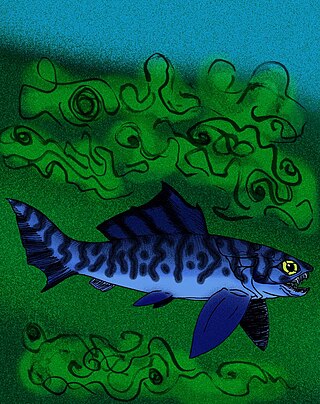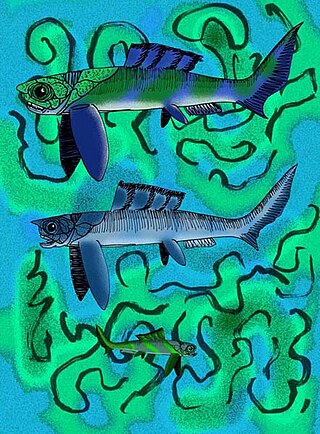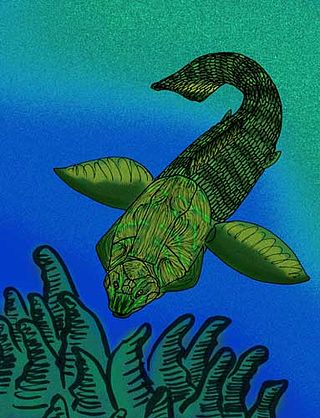
Bothriolepis was a widespread, abundant and diverse genus of antiarch placoderms that lived during the Middle to Late Devonian period of the Paleozoic Era. Historically, Bothriolepis resided in an array of paleo-environments spread across every paleocontinent, including near shore marine and freshwater settings. Most species of Bothriolepis were characterized as relatively small, benthic, freshwater detritivores, averaging around 30 centimetres (12 in) in length. However, the largest species, B. rex, had an estimated bodylength of 170 centimetres (67 in). Although expansive with over 60 species found worldwide, comparatively Bothriolepis is not unusually more diverse than most modern bottom dwelling species around today.

Drepanaspis is an extinct genus of primitive jawless Ostracoderms from the Early Devonian that belonged to the phylum Chordata, infraphylum Agnatha, class Pteraspidomorphi, and the subclass Heterostraci. Drepanaspis are assumed to have lived primarily in marine environments and is most commonly characterized by their ray-like, heavily armored bodies, along with their lack of paired fins and jaws.

Groenlandaspis is an extinct genus of arthrodire from the Late Devonian. Fossils of the different species are found in late Devonian strata in all continents except eastern Asia. The generic name commemorates the fact that the first specimens of the type species were found in Greenland.

Cherax parvus is a species of crayfish in the family Parastacidae. It is only known from its type locality – the Upper Tully River catchment in the Cardwell Range of north-eastern Queensland – and is listed as data deficient on the IUCN Red List. It was discovered in a rainforest catchment in a highland of northeastern Queensland during a Queensland Museum expedition to the upper Tully River area in November 1992. It is one of the smallest species in the genus. No species of Cherax has been considered endemic to wet upland or highland areas before it was discovered; most previous records were from elevations less than 400 meters. It also has several morphological features unique to the genus, and does not appear closely related to any extant species, suggesting a long period of geographic isolation.

Lunaspis is an extinct genus of armor-plated petalichthyid placoderm fish that lived in shallow marine environments of the Early Devonian period, from approximately 409.1 to 402.5 million year ago. Fossils have been found in Germany, China and Australia. There are three different identified species of within the genus Lunaspis: L. broilii, L. heroldi, and L. prumiensis.

Holonema is an extinct genus of relatively large, barrel-shaped arthrodire placoderms that were found in oceans throughout the world from the Mid to Late Devonian, when the last species perished in the Frasnian-Fammian extinction event. Most species of the genus are known from fragments of their armor, but the Gogo Reef species, H. westolli, is known from whole, articulated specimens.

Murrindalaspis is an extinct genus of acanthothoracid placoderm found in the McLarty Member of the Murrindal Limestone, of the Early Devonian-aged Buchan Group in eastern Victoria, Australia. Murrindalaspis differs from other acanthothoracids by having a dorsal plate with a large, blade-like flattened, recurved crest emanating from the medial line, and no ventral keel. So far, the genus is known only from dorsal plates and ossified eyeballs. The genus differs from the closely related Weejasperaspis in that the dorsal crest of the latter is shorter, and triangular-shaped.

Selenosteus brevis is an extinct large selenosteid arthrodire placoderm known from the Famennian Cleveland Shale of Ohio. Scrappy remains from the Frasnian Rhinestreet Shales of Erie County, New York, were attributed by Hussakof and Bryant to this genus in 1919, but, this identification is doubtful. A second species, S. kepleri, was described in 1901, but, not enough differences can be seen between its specimens, and those of the type species to warrant new species status.

Hadrosteus is an extinct monospecific genus of large arthrodire placoderm from the Late Frasnian Kellwasserkalk facies of Bad Wildungen, Germany. It had large, double-pronged inferognathals, and serrated edges along its mandible, strongly suggesting that it was a fish-eating predator. The head had a triangular snout, and the trunkshield was short, but high, with a median dorsal plate that was broader than wide. The average skull length is about 16 centimeters.

Rhinosteus is an extinct genus of small to medium selenosteid arthrodire placoderms of the Late Devonian known from the Upper Frasnian Kellwasserkalk facies of Bad Wildungen, Germany and Morocco.

Pachyosteus is an extinct monospecific genus of medium-sized selenosteid arthrodire placoderm known from the Upper Frasnian Kellwasserkalk facies of Late Devonian Bad Wildungen, Germany and from the Famennian portions of the Holy Cross Mountains of Poland. The type species Pachyosteus bulla has a broad skull about 7 to 10 centimetres long, a comparatively long median dorsal plate, and a short rostral plate that meets the pineal plate.

Holonematidae is an extinct family of relatively large arthrodire placoderms from the Early to Late Devonian. Almost all fossil specimens are of armor fragments, though, all have distinctive ornamentation, often of unique arrangements and patterns of tubercles, that are diagnostic of the family. The trunkshield is very elongated, giving the armor an overall "barrel" like appearance.

Yunnanolepididae is an extinct family of primitive Antiarch placoderms characterized by having short, broad skull roofs, and by having a feature on the visceral side of the posterior medial dorsal plate, the crista transversalis interna posterior, which is diagnostic of antiarchs, turning forward, and lying in front of the posterior ventral process and pit.

Aspidichthys is a genus of large, distinctively tuberculated arthrodire placoderm of uncertain affinities from Upper Devonian marine strata in the Eastern United States and Europe.

Brachydeiridae is a family of small to moderately large-sized arthrodire placoderms from the Late Devonian of Europe, restricted primarily to the Kellwasserkalk Fauna of Bad Wildungen and Adorf.

Brachydeirus is a genus of small to moderately large-sized arthrodire placoderms from the Late Devonian of Europe, restricted to the Kellwasserkalk Fauna of Bad Wildungen and Adorf.
Microbrachius is an extinct genus of tiny, advanced antiarch placoderms closely related to the bothriolepids. Specimens range in age from the Lower Devonian Late Emsian Stage to the Middle Devonian Upper Givetian Stage. They are characterized by having large heads with short thoracic armor of an average length of 2-4 cm. There are patterns of small, but noticeable tubercles on the armor, with the arrangement varying from species to species. Specimens of Microbrachius have been found in Scotland, Belarus, Estonia, and China.

Asterolepis is an extinct genus of antiarch placoderms from the Devonian of North and South America and Europe. They were heavily armored flat-headed benthic detritivores with distinctive jointed limb-like pectoral fins and hollow spine. The armor plate gives the Asterolepis a box-like shape. Its pectoral fins are also armored but the caudal and dorsal fin are not. The first fossils were named by M. Eichwald in 1840 after noticing star-like markings on the fossils.

Qilinyu is a genus of early placoderm from the late Silurian of China. It contains a single species, Qilinyu rostrata, from the Xiaoxiang fauna of the Kuanti Formation. Along with its contemporary Entelognathus, Qilinyu is an unusual placoderm showing some traits more similar to bony fish, such as dermal jaw bones and lobe-like fins. It can be characterized by adaptations for a benthic lifestyle, with the mouth and nostrils on the underside of the head, similar to the unrelated antiarch placoderms. The shape of the skull has been described as "dolphin-like", with a domed cranium and a short projecting rostrum.

Kimbryanodus is a genus of extinct ptyctodontid placoderm fish from the Frasnian of Australia.These placoderms can be told apart from others due to the large eyes, crushing tooth plates, long bodies, reduced armor, and a superficial resemblance to holocephalid fish. The group is so far the only Placoderms known with sexually dimorphic features. The fossils occur as small three dimensional isolated plates. Because of these new specimens the Ptyctodontid grouping got a taxonomic classification, it found that the genus Rhamphodopsis to be the most basal taxa. They are divided by having the more basal taxa having a median dorsal spine, a simple spinal plate, and a simple V-shaped overlap of the anterior lateral and the anterior dorsolateral plates.


























